Chapter Twenty Three
Escape of Saddam’s Nuclear Scientist
I mentioned Imad Khadduri the Nuclear Physicist earlier in Chapter 5. In 1961 he received an acceptance from the University of Michigan to pursue a post graduate degree in Physics. He was immediately offered a nine-year Iraqi government-funded scholarship to pursue a nuclear physics programme in the United States. This would, of course, have entailed a continuing commitment to working for the Iraqi Government on completion of the scholarship. However, his father intervened and funded Imad’s studies to relieve him of any commitment to the government. Imad collected an MSc from the University of Michigan and then moved to the University of Birmingham where he obtained a PhD in Nuclear Reactor Technology in 1973. He worked in the Iraqi Atomic Energy Commission at Tuwaitha under Dr Jaffar A Jaffar from 1974 until 1997.
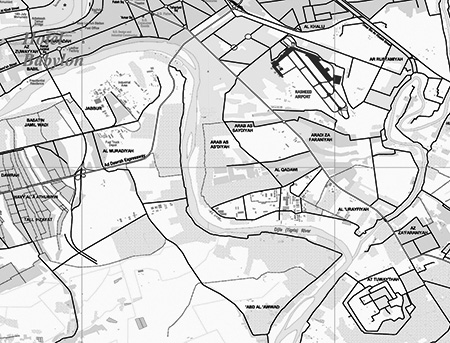
Map showing proximity of Al Tuwaythah and Rasheed Air Base to the Hotel Babylon (in top left corner).
The map is derived from the 2006 Special Reference Graphic Map of Baghdad by NIMA by courtesy of the University of Texas Libraries, The University of Texas at Austin. The legends in italics are the authors own) This map was developed using materials from the United States National Imagery and Mapping Agency and are reproduced with permission, also this product has neither been endorsed nor authorized by the United States National Imagery and Mapping Agency or the United States Department of Defence.
I met him in January 1998 when I started in Iraq. He had joined UNDP in April 1997 and that made him one of the longest serving members in the electricity sector. I often came across him later as well on my frequent visits to Baghdad from Kurdistan and discussed communications and computers as well as system planning software problems with him. Each time he spoke at length of his longing to take his family to Jordan to join his wife who was teaching there and each time he was waiting for an answer to the latest request for exit visas. In his case the requests would have to be adjudicated on by Saddam himself. The work that Imad had engaged in was delicate in the extreme as it involved Iraq’s WMD programme. Saddam had to persuade the Americans that the bomb programme was dead but at the same time give the Iranians the impression that it was still very much alive. If Imad was released the Americans would not officially believe him anyway but the (Persians) Iranians might. There was then the real possibility that Iran would attack and Iraq, weakened after years of sanctions would not be able to defend itself. So each time the result was a refusal from Saddam and as the months passed Imad became more and more despondent.
Suddenly Imad and his children disappeared in early August and all hell broke loose. Odeh was away on business at the time and was livid when he heard the news. He was called in to the Ministry of Foreign Affairs (MOFA) to explain the circumstances to the Iraqi Government. He claimed that the Mukhabarat slant on the story was that Imad had crossed into Turkey at Zahko. They further claimed that they had intercepted emails between Dr Ayad, the driver from the UNDP office, and members of the Iraqi resistance in Turkey. The emails concerned arrangements regarding Imad crossing into Turkey at Zahko. The information that the Mukhabarat had the ability to read emails on the UN network made me transmit many of my messages to my HQ in Dublin in Gaelic and I smiled as I visualized the Iraqis trying to decipher them. This practice may have become more widespread as Gaelic was used by the Americans when they intercepted Russian Intelligence information from an underground cable in Berlin during the Cold War. I note that the Chinese are now giving a Gaelic course at one of their Universities. Are they preparing for WW3? Gaelic is almost extinct in Ireland so what is their rationale?
What incensed Odeh was that in order to cross into Turkey, Imad had to have UN travel documents to go north to Kurdistan and probably travelled in UN transport. Furthermore he had to have his travel documents stamped with the UNDP office seal. It transpired that only a few people would have had access to the seal. These were Murthy and Peter Kouwenberg, the Deputy Residential Representative, both not exactly bosom friends of Odeh. The Mukhabarat quizzed Peter at length and probably Murthy.
To further their investigation the Mukhabarat insisted that all UN personnel in the north give an account of their travel movements over the previous month. This was difficult for me as I was travelling constantly around Iraqi Kurdistan but thankfully had not been anywhere near Zahko. The Mukhabarat would then check each journey against the records at each of their checkpoints and presumably the UN log of such journeys. The impression in the UN office was that Murthy and Ayad were under suspicion. This was reinforced when Ayad left the UN service. I was surprised having regard to the seriousness of the alleged crime that he was not arrested and it was said that he had powerful relatives in the Iraqi military that protected him. Also Murthy was still working in Iraq. If the UN slant on the story was correct he would have been declared persona non grata immediately and he was not. The only reference Murthy made to me regarding the incident was when he joked one evening that: “They say I helped Khadduri to escape.” However, Imad had a different spin on the story. When he escaped he made his way to Canada and worked as a network administrator in Toronto. He is a passionate Iraqi nationalist and while he had no reason to support Saddam he took every opportunity to broadcast the true story of the Weapons of Mass Destruction on radio and television and the paper media before the invasion of Iraq. He has been interviewed by the International Atomic Energy Agency, CBC, FOX, ABC, MSNBC, BBC, CTV, The Toronto Star, Reuters, Democracy Now, Dubai Business TV Channel, al-Jazeera satellite channel and many others. The details of these broadcasts can be accessed on the internet by typing in ‘Imad Khadduri’ on any reputable search engine. He wrote a largely autobiographical book titled Iraq’s Nuclear Mirage, Memoirs and Delusions published by Springhead Publishers of Canada.
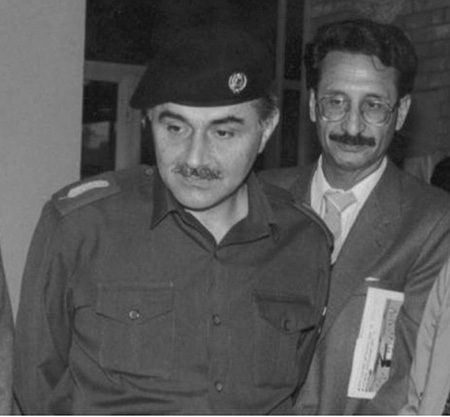
Dr Imad Khadduri on right with Dr Jaffar Dhia Jaffar.
Photo by kind permission of Dr. Imad Khadduri.
In this book he claims that he escaped from Iraq by crossing the border at Traibil into Jordan. He used documentation that was quite expensive to obtain as well as bribery at the border post itself. I met Imad by chance in Amman some time after these events. I was staying in the Middle East Hotel on the street with the forgettable name of Ash Sharif Nasir Ibn Jamil Street and I was browsing through the nearby Safeway supermarket in the Shmeisani District when I was saluted by this tall distinguished looking man; it was Imad Khadduri. He certainly was not dressed to blend in with his surroundings. His hair was jet black as was his waxed moustache. He looked more like Groucho Marx than ever. As far as I remember he wore a bow tie. With Saddam’s agents freely roaming around Amman I felt that he was foolhardy to advertise himself in such a way and we had a long chat. He was ebullient and it was very obvious that all was well with his world.
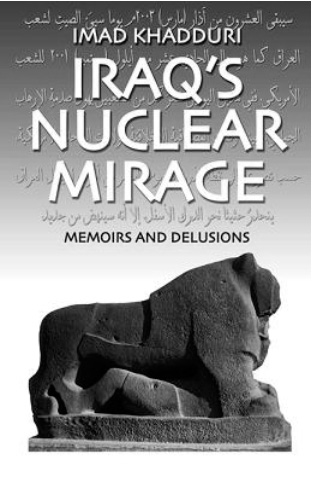
Dr Imad Khadduri’s Book.
Photo by kind permission of Dr. Imad Khadduri.
In his book he had high praise for Peter Kouwenberg, the Deputy Res Rep (UN Ambassador), an opinion I shared. After Imad’s departure the Mukhabarat interviewed some of his colleagues in UNDP Baghdad particularly Peter. To quote from Imad’s book regarding his escape: ‘I consulted Abu Diyar. He phoned his friends back in Baghdad to get a sense of the Intelligence reaction, conversing in coded dialog. He learned of Abid Himood’s hurried committee’s investigation of our departure at the border crossing of Traibil’.
(Note: Lieutenant General Abid Al-Himoood Mahmud al-Tikriti was Saddam’s personal secretary as well as his most senior bodyguard and National Security Advisor. He was literally Saddam’s right-hand man usually sitting at his right hand in all cabinet meetings. It gave him great power as he controlled access to Saddam. He was designated ‘ace of diamonds’ in the US administrations most wanted Iraqi playing cards and fourth on the most wanted list after Saddam and his sons.)
They were also intensely interviewing my colleagues at the UNDP … particularly Peter (Kouwenberg), the Deputy, Peter … faithfully remained in contact with me and visited me with his family on their way through Jordan several months later.
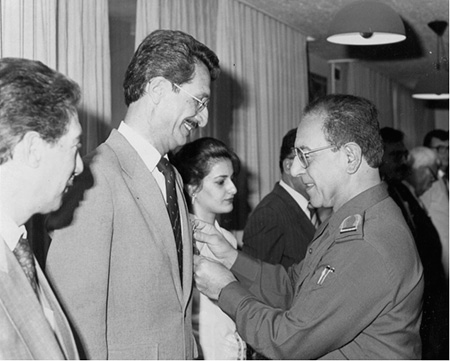
Imad being presented with a medal by Mohammed Saeed al-Sahhaf Foreign Minister of Iraq in 1996.
Imad is a true blue Iraqi Patriot as he demonstrated over and over again when he refuted the claims of President Bush et al of the existence of nuclear weapons in Iraq. He gave many interviews on very influential channels but his evidence was not what the American media wanted to hear at that time.
Imad was presented with a medal by Mohammed Saeed al-Sahhaf Foreign Minister of Iraq in 1996. Al- Saeed was demoted by Saddam as Foreign Minister in 2001, some claim at the instigation of Saddam’s son Uday. He was then appointed Minister for Information. He is now living in the United Arab Emirates with his family. Al Saeed was famous in the West for his information communiqués during the final actions of the war. He was known as Baghdad Bob and as Comical Ali in the Western media. He was in the grand tradition of Tokyo Rose and Lord Haw-Haw as he solemnly regaled his listeners with tales of the allied defeat as American tanks were streaming into Baghdad.
Imad is now working at the Qatar Foundation as a Special Projects Manager for the Undergraduate Research Experience Program and Dr Jaffar is living with his family in Syria.
Dr. Ayad is living in the UK with his family.
At weekends we went on excursions outside Erbil. Picnics were the customary outings for Kurdish families. They used to drive out to the picnic areas and spend the afternoon dining and dancing to Kurdish music. One spring Friday we had an office picnic just outside Erbil on the famous Hamilton Road named after the New Zealand Engineer who built it. This road travels on to the Iranian border via Rowanduz and I shall refer to it again in my narrative. The atmosphere in the picnic area was happy and friendly and we were welcomed to join some family groups to share their repast and dance the hours away with them. We were then joined by two enterprising young musicians who entertained us on their kettle drum for the rest of the afternoon as they wittily and cleverly ad-libbed the words.
I was a constant visitor to Shawqala during the weekends. It is a resort 50 km north of Erbil and is situated between Safeen Mountain and Sork Mountain, and is famous for its fruit and honey. Its orchards produce grapes and pomegranates, apples and pears in abundance. The town has a strong Christian presence and Farhad’s family has a house there. I was invited to spend many a week-end there but never took up on the offer as I was loath to impose myself on what was an extended family resource.
It was sheltered by many leafy shrubs and trees and it had many beer gardens where one could imbibe the fruit of the barley as gentle cooling breezes wafted through the leaves. I was drinking some beer with friends in a beautiful garden beside the road one weekend. An obviously large American car drew up and the driver also an obvious American spoke with us. He said he was working with the local universities but his chrome plated monster and himself screamed CIA to the mountain tops. A cadre of CIA had been operating in Barzani’s HQ, in nearby Sari Rush, for a time, but was supposed to have gone home when Saddam ordered Americans and British citizens from Iraq after the December bombing. It’s a cause of wonder that so-called under-cover agents seem to go out of their way to contradict their cover.
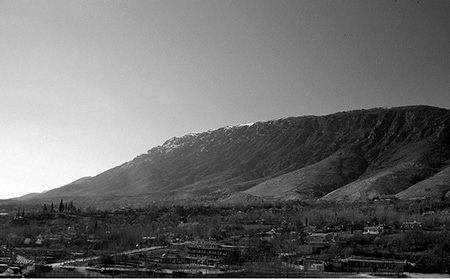
The town of Shaqlawa. It was from the top of Safeen Mountain that Talabani’s men shelled Shaqlawa at the beginning of the last war between Barzani and Talabani that ended in 1998.
Photo source: Kosar Nuradeen.
The town itself was on the north-facing slope of Safeen Mountain looking across at a cliff of bare rocks of varied and vivid hues. The place must be bursting with ores of every conceivable metal. I know that Imad Khadduri was prospecting there for raw material for the Iraqi Nuclear programme. That it is there in abundance gives the lie to the charges that the Iraqis were buying nuclear material in Nigeria. Why should they when they had plenty in their own back yard? Shaqwala is on one of the ancient routes between Mesopotamia and Persia and this route has soaked much blood over the centuries. This place was well known during the 1974-75 war when Mustafa (Barzani) took on the Iraqi army. He decided that the battle ground would be in the Zagros Mountains that looped in a curve from Zakho near the Turkish border to Derbendikhan near the Iranian border.
He was supplied with American arms by the Shah of Iran and these were delivered to him through the Choman Valley on the road to Rawanduz. While Barzani was supplied with state of the art weaponry the Shah kept control by rationing the ammunition he funneled through.
The Iraqi Army advanced in an arc up through Barzani’s line starting at Zakho, then through Amadiya, Aqra and Rawanduz where they unexpectedly camped over the Kurdish winter to prevent Barzani’s army from regrouping and resupplying. In 1975 Saddam met the Shah at an OPEC meeting in Algiers and they signed what came to be known as the Algiers Agreement. In it Saddam agreed to cede part of the Shatt al Arab to the Shah if he ceased supporting the Kurds. The Shah agreed and the Kurds were finished. About 100,000 peshmergas and their families retreated north from Rawanduz and retraced the Iranian supply route to seek asylum in Iran and join the 100,000 Iraqi Kurds already there. It was another example of the great powers aiding the Kurds and abandoning them when it suited. Great Britain, Turkey, the US and Iran behaved in this fashion over the years.
It is a matter of interest to recall that the Shatt al Arab agreement or as it is better known the Algiers Agreement was the one Saddam Hussein so publicly tore up on television in 1980 when he initiated the Iran-Iraq war.
The Shatt al Arab was the scene of fierce fighting during the Iran-Iraq war and when I worked there later was awe struck by the number of large shipping wrecks I encountered as I traveled down the Shatt from the Shatt al-Arab Hotel to meetings at Saddam’s opulent Palace a few miles down-stream from Basra.
On a few occasions I ventured further north along the Hamilton Road and came on the wrecks of some of Saddam’s T54/55 Russian battle tanks at the side of the road at Kore near Rawanduz. These tanks are the relics of the 1991 fighting when the Kurds in the North with the Shia’a in the South came out in rebellion after the Kuwait war believing the US would come to their aid. The US aid did not arrive and Saddam loosed his helicopter gun-ships, armour and artillery on them in a savage attack. The Kurds were driven back to Kore and decided to make their last stand there. After their initially successful defence Saddam halted his troops south of them. As the Iraqi Army was maneuvering to deliver the Coup de Grace to the Kurds the western powers stepped in and declared the Northern Governorates an autonomous zone and established safe havens for them. The US then defended the Kurds from the air and Saddam withdrew.
What a difference time makes. Some unlucky conscripts died a horrible death in these Kore tanks and those who loved them still mourn their loss. Now the wrecks are the playthings of children. At the present time they have been put on plinths and are regarded as a monument to the defeat of Saddam.
It is a matter of interest that the T54/55 tank was the most produced tank in history. Between 1945 when the Russians began to produce it to 1983 when the last T54/55 rolled out of the factory in Czechoslovakia more than 100,000 had been produced. The T54/55 with its 100mm Russian gun was outclassed by the Israelis in the 1967 Six Day War who used a mix of WWII tanks but all were equipped with American 105mm guns. It was outclassed by the Israelis again in the 1973 war and was subsequently replaced as the main battle tank by most modern armies. However they formed part of the Iraqi Order of Battle in the second Gulf war of 2003 where many of them were destroyed by the superior modern Abrams Tank produced by the Americans in the 1980’s. It was certain death for the unfortunate conscripts that were forced to go into battle in these 55 year old deathtraps. I saw heaps of destroyed T54/55’s lining the desert around Basra after the war and thought of the fate of the crews (four men in each) who perished in them.